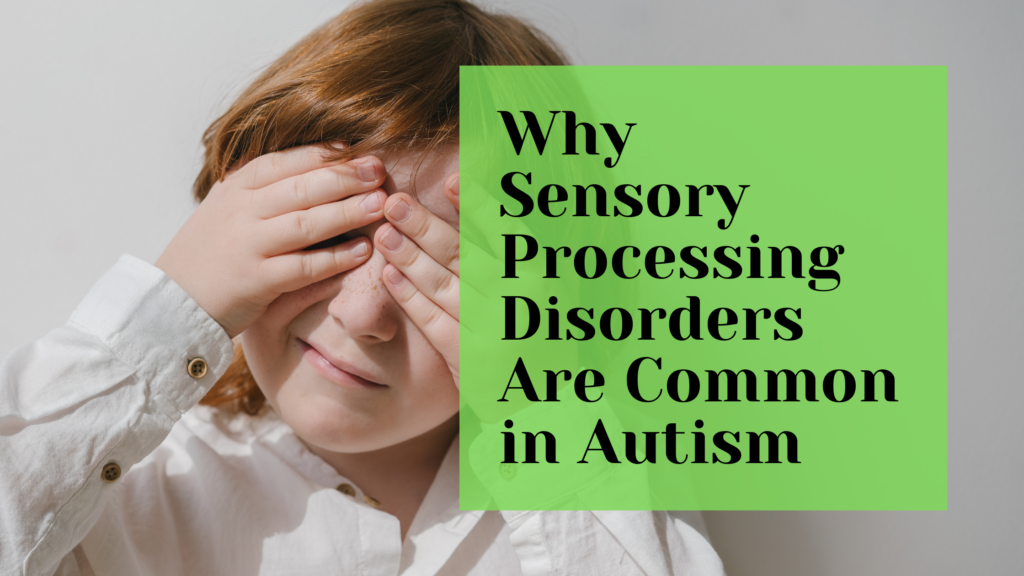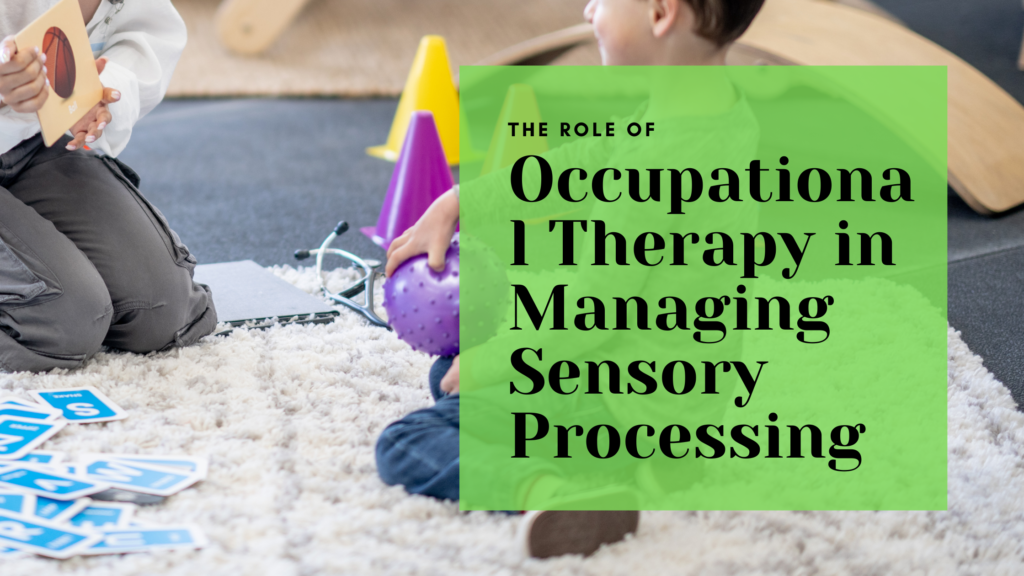I. Introduction
Autism spectrum disorder (ASD) is a developmental condition that affects communication, social interaction, and behavior. One of the significant challenges many individuals with autism face is sensory processing difficulties. Sensory processing refers to how the brain interprets and responds to information from the senses, like sight, sound, touch, and smell. For individuals with autism, sensory input can be overwhelming, leading to behavior that may seem confusing or challenging to others.
The purpose of this article is to explore the connection between sensory processing difficulties and behavior in people with autism. We will discuss the different types of sensory issues, how sensory processing affects behavior, and strategies for managing sensory challenges to improve daily life. By understanding this connection, caregivers, educators, and family members can help individuals with autism lead more comfortable and fulfilling lives.
II. What is Sensory Processing in Autism?
Sensory processing disorder (SPD) occurs when the brain has difficulty organizing and responding to sensory information. While SPD can occur in individuals without autism, it is very common among those with autism. In fact, research suggests that as many as 80-90% of individuals with autism experience some form of sensory processing difficulty .
The sensory experience for people with autism exists on a spectrum. Some individuals are hypersensitive, meaning they are overly responsive to sensory stimuli. For example, a sudden loud noise might feel physically painful to them. Others are hyposensitive, meaning they are under-responsive to sensory input. These individuals might seek out more intense sensory experiences, like touching rough textures or making loud noises themselves to feel grounded.
Common sensory modalities affected in autism include sight, sound, touch, taste, smell, and proprioception (awareness of body position and movement). Difficulties with these senses can significantly impact behavior, leading to responses that might include avoidance, agitation, or seeking specific sensory input for comfort.
III. How Sensory Processing Issues Impact Behavior in Autism
Sensory processing difficulties are closely linked to behavior in individuals with autism. When the brain struggles to manage sensory input, it can lead to behaviors that might be misunderstood. For example, when an individual with autism experiences sensory overload—when too much sensory information comes in at once—they may respond with behaviors like meltdowns, tantrums, or withdrawing from a situation.
Meltdowns are common responses to sensory overload and are not the same as typical tantrums. A meltdown is an intense reaction to being overwhelmed by sensory input, and the individual may struggle to calm down until the overwhelming input stops. On the other hand, sensory-seeking behaviors, such as rocking, spinning, or hand-flapping, are ways individuals with autism regulate their sensory input. These behaviors are often comforting because they help control sensory information in a way that feels manageable.
Understanding that these behaviors are linked to sensory processing difficulties allows caregivers and educators to respond more effectively and support the individual in a way that reduces stress.
IV. Types of Sensory Issues in Autism and Their Behavioral Effects
1. Hypersensitivity:
Hypersensitivity, or over-responsiveness to sensory input, is common in autism. Individuals who are hypersensitive may react strongly to stimuli that seem ordinary to others, like the sound of a vacuum cleaner or the brightness of overhead lights. They might cover their ears, avoid eye contact, or even have a meltdown to escape the overwhelming stimuli.
2. Hyposensitivity:
In contrast, individuals with hyposensitivity are under-responsive to sensory stimuli. They may crave intense sensory experiences to feel balanced. This can lead to behaviors like crashing into things, making loud vocalizations, or excessively touching objects. These individuals may not feel sensations as strongly as others, which can also affect safety, like not noticing pain when touching hot objects.
3. Sensory Overload:
Sensory overload happens when an individual receives too much sensory input at once. This can lead to behaviors like meltdowns, anxiety, or attempts to escape the situation. Crowded spaces, loud environments, or bright, chaotic visuals are typical triggers for sensory overload. For individuals with autism, public spaces like malls, schools, or busy events can be particularly challenging.
V. Identifying Sensory Triggers and Behavioral Patterns
Recognizing sensory triggers is a key step in managing sensory-related behaviors. Sensory triggers are specific stimuli that cause discomfort or distress. To identify these triggers, caregivers and educators can observe the individual’s behavior in various environments and note when certain reactions occur. For instance, does the individual start to cover their ears in noisy places? Or do they seem to seek out rough textures in moments of stress?
Sensory assessments conducted by professionals, like occupational therapists, are also useful. These assessments can help pinpoint the specific sensory modalities affected and guide the development of an intervention plan.
Tracking behaviors and sensory triggers using behavior logs or journals is another valuable tool. This practice can reveal patterns between sensory stimuli and behavioral reactions, helping caregivers and therapists create better intervention strategies. For example, if a child regularly has meltdowns in brightly lit classrooms, adjustments can be made to reduce the lighting intensity to create a more sensory-friendly environment.
VI. Sensory Tools and Strategies for Behavior Management
There are many tools and strategies that can help individuals with autism manage their sensory input and improve behavior. Some of the most effective tools include:
- Weighted blankets: These provide deep pressure stimulation, which can help calm and soothe individuals experiencing sensory overload.
- Fidget toys: These offer tactile stimulation and can help individuals focus by providing a controlled sensory experience.
- Noise-cancelling headphones: These reduce loud or unpredictable noises that might trigger a negative behavioral response.
Environmental Modifications:
Creating sensory-friendly environments is another important strategy. Sensory-friendly spaces can include quiet rooms with soft lighting, minimal clutter, and soothing sensory objects like pillows or weighted blankets. Adjusting the environment to meet the individual’s sensory needs can reduce the chances of sensory overload and improve their overall behavior.
Therapeutic Strategies:
Therapies like sensory integration therapy and occupational therapy are also helpful for managing sensory input. Sensory integration therapy helps individuals process sensory information more effectively by exposing them to controlled sensory activities. Occupational therapy can teach individuals how to handle sensory input more comfortably, improving both sensory regulation and behavioral responses.
VII. Coping Strategies for Managing Sensory-Related Behaviors
For individuals with autism, having coping strategies in place can be life-changing. These strategies can help manage sensory-related behaviors in a variety of settings.
Grounding Techniques:
Grounding techniques like deep breathing, sensory breaks, and the use of sensory objects can help individuals manage feelings of overwhelm. For example, taking a short break in a quiet room or focusing on deep breathing can reduce the stress caused by sensory overload.
Structured Routines:
Structured routines provide predictability and security, which are particularly important for individuals with sensory challenges. When the day follows a consistent routine, individuals know what to expect, which can reduce the anxiety and behavioral issues caused by sensory unpredictability.
Gradual Exposure:
Another effective strategy is gradually exposing individuals to challenging sensory environments. This process, called desensitization, helps them build tolerance to stimuli that would otherwise be overwhelming. For example, starting with a short visit to a busy grocery store and gradually increasing the time spent there can help an individual adjust to the sensory experience over time.
VIII. Supporting Caregivers and Educators in Managing Sensory-Related Behaviors
Collaboration between caregivers and educators is essential for managing sensory-related behaviors effectively. Together, they can create consistent sensory-friendly environments both at home and in school. Open communication allows everyone involved to share observations about sensory triggers and responses, leading to more targeted strategies.
Educating caregivers and teachers about sensory processing and how it affects behavior is crucial. When they understand the connection between sensory input and behavior, they can better support individuals with autism by providing appropriate sensory tools and making necessary environmental modifications.
Additionally, caregivers managing children with sensory-related behaviors often experience stress and emotional challenges. It’s important to offer emotional support to caregivers and encourage them to seek help from professionals and support groups.
IX. The Role of Professional Support in Managing Sensory Processing and Behavior
Professional support plays a significant role in managing sensory processing difficulties and their impact on behavior. Occupational therapists, behavioral therapists, and speech-language pathologists can provide specialized interventions that help individuals regulate sensory input and improve behavior. For example, occupational therapists can develop sensory diets—personalized plans of sensory activities that help maintain balance throughout the day.
Individualized therapy plans are important because every person with autism experiences sensory processing differently. Professionals can assess sensory needs and tailor therapies to meet the specific needs of the individual. Early intervention is particularly beneficial, as it allows for timely support and helps prevent sensory-related behaviors from becoming more severe.
X. Conclusion
Sensory processing plays a significant role in the behavior of individuals with autism. Understanding the connection between sensory input and behavior is essential for helping them navigate daily life more easily. Identifying sensory triggers, using appropriate tools and strategies, and seeking professional support can make a meaningful difference in managing sensory-related behaviors.
By creating sensory-friendly environments and incorporating structured routines, caregivers and educators can improve the quality of life for individuals with autism. Ongoing learning about sensory processing and behavior management is key to supporting these individuals effectively and ensuring their comfort and well-being.
Here’s a table with 10 key points based on the article:
| # | Key Point | Description |
|---|---|---|
| 1 | Understand the Sensory Spectrum | Sensory processing in autism varies from hypersensitivity (over-responsiveness) to hyposensitivity (under-responsiveness). |
| 2 | Recognize Sensory Triggers | Identifying specific sensory triggers helps in reducing challenging behaviors and preventing sensory overload. |
| 3 | Link Behavior to Sensory Input | Many behaviors, such as meltdowns or self-stimulatory activities, are responses to sensory processing challenges. |
| 4 | Differentiate Hypersensitivity and Hyposensitivity | Hypersensitive individuals may avoid stimuli (e.g., loud noises), while hyposensitive individuals may seek intense input (e.g., rough textures). |
| 5 | Use Sensory Tools | Tools such as noise-cancelling headphones or weighted blankets can help manage sensory input and improve behavior. |
| 6 | Create a Sensory-Friendly Environment | Design spaces with reduced sensory stimuli, such as quiet zones and soft lighting, to help ease sensory overload. |
| 7 | Track Behavioral Patterns | Keep a log of sensory triggers and corresponding behaviors to better understand how sensory issues affect daily life. |
| 8 | Incorporate Structured Routines | Consistent routines help individuals with autism feel secure and minimize unpredictable sensory stimuli. |
| 9 | Collaborate with Professionals | Occupational therapists and sensory integration specialists can help create personalized strategies to manage sensory-related behaviors. |
| 10 | Support Caregivers and Educators | Providing resources and support to caregivers and teachers is essential in managing sensory issues in different environments. |
These points summarize the main takeaways from the article, offering practical insights for managing sensory processing challenges and their effects on behavior.


